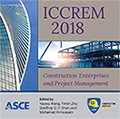International Conference on Construction and Real Estate Management 2018
Modeling the Effect of Group Norms on Construction Workers’ Safety Behavior
Publication: ICCREM 2018: Construction Enterprises and Project Management
ABSTRACT
The construction industry has long been notorious for frequent accidents and high injury rate. So far, construction workers’ unsafe behaviors have been identified as the main cause of accidents. Researchers working on the social influence on workers’ safety behavior propose that group norms play a significant role in shaping workers’ safety behavior. However, how group norms influence workers’ safety behavior and the influence path of group norms on safety behavior are still uncertain. Therefore, this study aims to construct a model based on the theory of planned behavior to explain the effect of group norms on workers’ safety behavior. Empirical data were collected from workers on construction sites and a structural equation modeling (SEM) analysis was employed to test the proposed hypotheses. Results demonstrated that attitudes, personal norm, and intention mediated the effect of group norms on workers’ safety behavior. This paper contributes to a better understanding on how group norms transform into workers’ safety behavior and lays the foundation for developing new methods for safety management in construction.
Get full access to this article
View all available purchase options and get full access to this chapter.
ACKNOWLEDGMENT
This work was supported by the National Natural Science Foundation of China [grant number 71471023]; Fundamental Research Funds for the Central Universities [grant number 106112016CDJSK03XK07]; Youth Foundation of Ministry of Education of China [grant number 12YJCZH255].
REFERENCES
Ajzen, I. (1991). “The theory of planned behavior.” Organizational Behavior and Human Decision Processes, (50), 179-211.
Berkowitz, A.D. (1997). “Section 3: Substance abuse on campus: a handbook on substance abuse for college and university personnel.” From reactive to proactive prevention: promoting an ecology of health on campus, Greenwood Press, Westport, 120-139.
Bentler, P.M. (1999). “Cutoff criteria for fit indexes in covariance structure analysis: Conventional criteria versus new alternatives.” Structural Equation Modeling, 6(1), 1-55.
Brondino, M., Silva, S.A. and Pasini, M. (2012). “Multilevel approach to organizational and group safety climate and safety performance: Co- workers as the missing link.” Saf. Sci., 50(9), 1847-1856.
Choi, B., Ahn, S. and Lee, S. (2017). “Construction workers' group norms and personal standards regarding safety behavior: Social Identity Theory Perspective.” Journal of Management in Engineering, 33(4), 401-701.
Cialdini, R.B., Reno, R.R. and Kallgren, C.A. (1990). “A focus theory of normative conduct: recycling the concept of norms to reduce littering in public places.” Journal of Personality and Social Psychology, (58), 1015-1026.
Conner, M. and Armitage, C.J. (1998). “Extending the theory of planned behavior: A review and avenues for further research.” Journal of Applied Social Psychology, (28), 1429-1464.
Conner, M. and Sparks, P. (2006). “Theory of planned behavior and health behaviors.” Predicting Health Behavior: Research and Practice with Social Cognition Models, Open University Press, Buckingham, UK, 121-162.
Fang, D., Zhao, C. and Zhang, M. (2016). “A cognitive model of construction workers' unsafe behaviors.”Journal Of Construction Engineering And Management, 142(9), 114-154.
Fogarty, G.J. and Shaw, A. (2010). “Safety climate and the theory of planned behavior: towards the prediction of unsafe behavior.” Accid. Anal. Prev., 42(5), 1455-1459.
Fugas, C.S., Silva, A. and Melia, J.L. (2012). “Another look at safety climate and safety behavior: deepening the cognitive and social mediator mechanisms.” Accident Analysis and Prevention, (45), 468-477.
Goh, Y. and Binte Sa’adon, N. (2015). “Cognitive factors influencing safety behavior at height: A multimethod exploratory study.” Journal of Construction Engineering & Management, 141(6).
Heinrich, H.W., Petersen, D., Roos, N.R., Brown, J. and Hazlett, S. (1980). Industrial Accident Prevention: A Safety Management Approach, McGraw-Hill, New York.
Kline, R. B. (2005). Principles and Practice of Structural Equation Modeling, Guilford Press, New York.
Nunnally, J.C. and Berstein, I.H. (1994). Psychometric theory, McGraw-Hill, New York.
Neal, A., Griffin, M.A. and Hart, P.M. (2000). “The impact of organizational climate on safety climate and individual behavior.” Safety Science, 34(1), 99-110.
Parker, D., Manstead, A.S.R. and Stradling, S.G. (1995). “Extending the theory of planned behaviour: The role of personal norm.” British Journal of Social Psychology, (34), 127-137.
Parker, D., Reason, J.T., Manstead, A.S.R. and Stradling, S.G. (1995). “Driving errors, driving violations and accident involvement.” Ergonomics, 38(5), 1036-1048.
Reason, J., Manstead, A. and Stradling, S. (1990). “Errors and violations on the roads: a real distinction.” Ergonomics, 33(10), 1315-1332.
Rivis, A. and Sheeran, P. (2003). “Social influences and the theory of planned behaviour: Evidence for a direct relationship between prototypes and young people’s exercise behavior.” Psychology and Health, (18), 567-583.
Schwartz, S.H. and Howard, J.A. (1981). “Section 5: Altruism and helping behavior.” A Normative Decision-making Model of Altruism, Lawrence Erlbaum, Hillsdale, 189-211.
Terry, D.J. and Hogg M.A. (1996). “Group norms and the attitude-behavior relationship: A role for group identification.” Personality and Social Psychology Bulletin, 22(1996), 776-793.
White, K.M., Robinson, N.G. and Young, R.M. (2008). “Testing an extended theory of planned behaviour to predict young people’s sun safety in a high risk area.” British Journal of Health Psychology, 13(2008), 435-448.
White, K.M., Smith, J.R. and Terry, D.J. (2009). “Social influence in the theory of planned behaviour: The role of descriptive, injunctive, and in-group norms.” British Journal of Social Psychology, 48(2009), 135-158.
White, K.M., Starfelt, L.C. and Young, R.M.D. (2015). “Predicting australian adults' sun-safe behavior: examining the role of personal and social norms.” British Journal of Health Psychology, 20(2), 396-412.
Information & Authors
Information
Published In
ICCREM 2018: Construction Enterprises and Project Management
Pages: 238 - 244
Editors: Yaowu Wang, Professor, Harbin Institute of Technology, Yimin Zhu, Professor, Louisiana State University, Geoffrey Q. P. Shen, Professor, Hong Kong Polytechnic University, and Mohamed Al-Hussein, Professor, University of Alberta
ISBN (Online): 978-0-7844-8175-2
Copyright
© 2018 American Society of Civil Engineers.
History
Published online: Aug 8, 2018
Authors
Metrics & Citations
Metrics
Citations
Download citation
If you have the appropriate software installed, you can download article citation data to the citation manager of your choice. Simply select your manager software from the list below and click Download.
